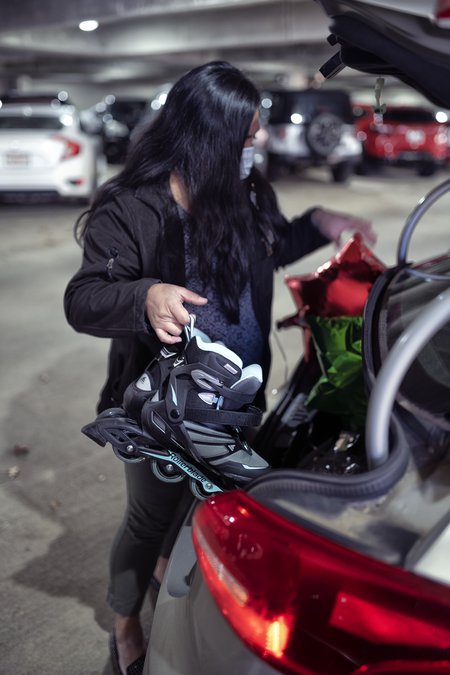Blasting “Like a Stone” by Audioslave, Diana Carrillo straps into her teal-and-black in-line skates and rolls through the Mundy Mill area where she can “sing and scream and just go as fast as I can.” It’s the 20 or 30 minutes when she can unwind from her day at The Heart Center of Northeast Georgia Medical Center in Gainesville.
“I just turn up my music,” said Carrillo, the center’s practice manager for the advanced heart failure program. “Nobody’s around, and even if they are, they usually run away because they’re scared I’m going to knock them over.”
The playlist for her skating is ‘90s alternative rock, filled with Green Day, Red Hot Chili Peppers Linkin Park and Evanescence.
Hometown heroes
COVID-19 has been hard on many, but for these frontline health care workers, its effects are an everyday reality. Over the next two weeks, we share the stories of a few of those who have risen to the occasion and done their jobs well in the face of unmatched pressure professionally and sometimes personally. We need heroes in this battle, and through their dedication, they have shown us what that looks like. We worked with Northeast Georgia Health System to identify those we are profiling, and this series is being made available free to nonsubscribers. Thank you to our subscribers for making our work possible. If you are not a subscriber, please consider supporting our work by subscribing to The Times. If you have a story about a frontline health care worker who has made a difference, please submit your story to news@gainesvilletimes.com. For other stories in this series, visit gainesvilletimes.com/hometownheroes.
Walking through a sports supplies store a while back, she saw the skates on the display that were straight out of the 1990s.
“I think I paid over $100. I didn’t care,” Carrillo said. “At the time, I was just like, ‘This is it.’”
When it gets to be stressful, Carrillo said she tries to go every day.
During the initial outbreak of COVID-19, she worked for a unit mostly based in the emergency room but moved over to The Heart Center in mid-April. Carrillo said the transition from hospital setting to outpatient was “eye-opening.”
“When we’re in the ER, it’s more like: What do we need to do to take care of the patient now? How do we protect ourselves? We don’t know what’s coming in,” she said.
In outpatient, it turned to more of how to continue to see patients and educate them on tele-health procedures. Carrillo’s work concerns mostly heart failure patients who need to be more closely monitored.
“This whole COVID situation has made it even harder to treat those patients, not being able to accommodate same-day appointments in person because maybe the patient was diagnosed with COVID recently, not being able to tell if they’re retaining fluid,” she said. “… That’s been the most challenging part of the day is being able to care for these patients (who) really need to be coming in once or twice a week.”
The patient population also includes those with left ventricular assist devices, medical instruments that pump the heart for patients either awaiting heart transplants or those who have exhausted other medications and treatments.
“These are very sick patients that you just don’t want to risk giving them COVID or exposing them to COVID, so the providers (who) see them, we have to care for them even more,” Carrillo said.
Though the hospital staff tries to stay positive, Carrillo said you can see the exhaustion in their faces who “can’t wait to step out of the building and take a break from their mask.”
“They know that at any moment, a potentially (COVID) positive patient can come into the building who is completely asymptomatic and expose them,” she said. “You just see it. You see them just trying to keep it together for their coworkers and for the remainder of the patients of the day.”


Praying for protection
Before she starts the day, Carrillo prays for her family, her coworkers and the patients to be protected.
Growing up Catholic, she said she never thought she would see the day that the church doors were closed.
“When I was not able to take Holy Communion, I knew that this was not going to be something that was going to go away and this was going to be life-changing,” she said.
Carrillo said she relied on her faith when her husband tested positive for COVID in July. Panic and anxiety can set in where you just “want to put your children in a bubble and disinfect your entire house,” Carrillo said.
“You know you’re breathing in the same air,” she said. “You know you’re sleeping next to the same person, and your children are interacting with that person. … That’s when you really rely on faith.”
Though her husband tested positive for nearly four weeks, no one else in the home tested positive, Carrillo said.
As a medical provider, she said she felt the persistent worry and subsequent pangs of guilt: Did I bring this home from work?
“I convinced myself that it’s in the community,” Carrillo said. “It’s out there. It’s everywhere. He could have gotten it from anywhere, and at this point it’s no use trying to figure out where he got it from. I just have to protect myself, protect my children and of course protect him.”




